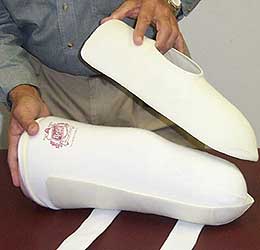Early Post-Operative Management
Role of the Lower Extremity Prostheses
- Replaces structural support to skeletal system
- Transfer support forces through the residual soft tissue through the femur
- Allows for upright activities (standing, transferring, and gait)
- In high-level patients, allows for return to work and sport
IPOP
Patients are initially fitted with a IPOP (immediate post-operative prosthesis) within 2-3 hours of amputation for edema management. Use of IPOPs can also promote wound/suture healing and minimize risk for falls when WB in the preparatory prosthesis.
The IPOP is fitted under anesthesia. Patients with fragile diabetes and advanced vascular disease may not be candidates for a IPOP, and will use soft dressings to help manage edema and promote healing.
Shrinkers are pull-on type socks which can offer swelling management when rigid dressing is removed (needs to be worn 24 hours/day
Preparatory Prosthesis
The type of preparatory prothesis is determined by the MD. This test prosthesis is fit as soon as suture is healed. The function of the prosthesis is to continue to reduce edema and allow for adjustability at the final fit and prosthesis type is determined. A patient may need multiple sockets as the side of the limb is reduced and it lacks complete cosmetic finish. Patients are often altering their gait as they learn to ambulate, so adjustability of the prosthesis is key.
Common pressure areas include condyles, fibula, tibial tuberosity, and posterior aspect of the knee
Role of Physical Therapy
Interventions post-amputation are directed at maximizing function and minimizing complications that result in poor prosthetic fit. The rehab team works closely with the patient to monitor skin, manage swelling, prevent falls, and recondition for the energy cost associated with donning/doffing and ambulating with a prosthetic limb.
- monitor WB status to prevent excessive early loading of healing residual limb
- stretching/strengthening exercises
- education in residual limb wrapping/stump shrinker; donning/doffing prosthesis
- positioning (bed and wheelchair) to optimize joint mobility
- wheelchair mobility and safety
- transfer training
- gait training with assistive devices
- skin/scar mobilization and monitoring
- desensitization
- phantom pain management
- progressive cardiovascular conditioning
- coordination with CPO (Certified Prosthetist and Orthotist) in artficial limb modification and management



